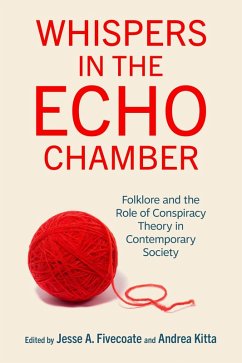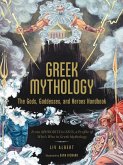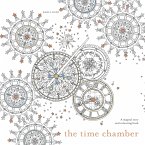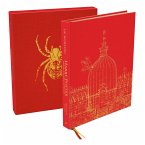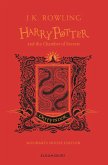Jesse A. Fivecoate, Andrea KittaFolklore and the Role of Conspiracy Theory in Contemporary Society
Whispers in the Echo Chamber
Folklore and the Role of Conspiracy Theory in Contemporary Society
Herausgeber: Kitta, Andrea; Fivecoate, Jesse A.
Jesse A. Fivecoate, Andrea KittaFolklore and the Role of Conspiracy Theory in Contemporary Society
Whispers in the Echo Chamber
Folklore and the Role of Conspiracy Theory in Contemporary Society
Herausgeber: Kitta, Andrea; Fivecoate, Jesse A.
- Gebundenes Buch
- Merkliste
- Auf die Merkliste
- Bewerten Bewerten
- Teilen
- Produkt teilen
- Produkterinnerung
- Produkterinnerung
Makes the case that conspiracy theories are fundamentally a folklore genre, akin to and often involving other belief narratives like rumor and legend
Andere Kunden interessierten sich auch für
![The Echo Chamber The Echo Chamber]() Michael BazzettThe Echo Chamber12,99 €
Michael BazzettThe Echo Chamber12,99 €![The Creative Echo Chamber The Creative Echo Chamber]() Dennis O. HowardThe Creative Echo Chamber23,99 €
Dennis O. HowardThe Creative Echo Chamber23,99 €![Greek Mythology: The Gods, Goddesses, and Heroes Handbook Greek Mythology: The Gods, Goddesses, and Heroes Handbook]() Liv AlbertGreek Mythology: The Gods, Goddesses, and Heroes Handbook10,99 €
Liv AlbertGreek Mythology: The Gods, Goddesses, and Heroes Handbook10,99 €![The Time Chamber The Time Chamber]() Daria SongThe Time Chamber27,99 €
Daria SongThe Time Chamber27,99 €![The Romance of the Western Chamber (Hsi Hsiang Chi) The Romance of the Western Chamber (Hsi Hsiang Chi)]() The Romance of the Western Chamber (Hsi Hsiang Chi)46,99 €
The Romance of the Western Chamber (Hsi Hsiang Chi)46,99 €![Harry Potter 2 and the Chamber of Secrets. Deluxe Edition Harry Potter 2 and the Chamber of Secrets. Deluxe Edition]() J.K. RowlingHarry Potter 2 and the Chamber of Secrets. Deluxe Edition143,99 €
J.K. RowlingHarry Potter 2 and the Chamber of Secrets. Deluxe Edition143,99 €![Harry Potter Harry Potter and the Chamber of Secrets. Gryffindor Edition Harry Potter Harry Potter and the Chamber of Secrets. Gryffindor Edition]() J.K. RowlingHarry Potter Harry Potter and the Chamber of Secrets. Gryffindor Edition13,99 €
J.K. RowlingHarry Potter Harry Potter and the Chamber of Secrets. Gryffindor Edition13,99 €-
-
Makes the case that conspiracy theories are fundamentally a folklore genre, akin to and often involving other belief narratives like rumor and legend
Produktdetails
- Produktdetails
- Verlag: University of Wisconsin Press
- Seitenzahl: 302
- Erscheinungstermin: 31. Januar 2025
- Englisch
- Abmessung: 235mm x 160mm x 22mm
- Gewicht: 576g
- ISBN-13: 9780299350604
- ISBN-10: 0299350606
- Artikelnr.: 71160673
- Herstellerkennzeichnung
- Libri GmbH
- Europaallee 1
- 36244 Bad Hersfeld
- gpsr@libri.de
- Verlag: University of Wisconsin Press
- Seitenzahl: 302
- Erscheinungstermin: 31. Januar 2025
- Englisch
- Abmessung: 235mm x 160mm x 22mm
- Gewicht: 576g
- ISBN-13: 9780299350604
- ISBN-10: 0299350606
- Artikelnr.: 71160673
- Herstellerkennzeichnung
- Libri GmbH
- Europaallee 1
- 36244 Bad Hersfeld
- gpsr@libri.de
Jesse A. Fivecoate, a folklorist and sociocultural anthropologist with a PhD from Indiana University, studies the use of communal belief narratives that circulate within a group as a way of remembering and discussing episodes of conflict and crisis. He is a coeditor of Advancing Folkloristics. Andrea Kitta is a folklorist and a professor of multicultural and transnational literature in the Department of English at East Carolina University. She is the author of Vaccinations and Public Concern in History: Legend, Rumor, and Risk Perception and The Kiss of Death: Contamination, Contagion, and Folklore as well as a coeditor of Diagnosing Folklore: Perspectives on Health, Trauma, and Disability.
Acknowledgments
Conspiracy Theory: A Folkloristic Introduction
Part I. Folkloric Approaches
1 What History Tells Us about QAnon
Bill Ellis
2 Interrogating “Conspiracism” and the Relationship between Historical and
Contemporary Conspiracy
David Guignion
Theories
3 The SLAP Test and Conspiracy Theories about COVID-19, Bill Gates, and the
Denver Airport
Jeannie Banks Thomas
4 QAnon in Four Pieces: Toward a Folkloric Understanding of a
Superconspiracy
John Bodner
Part II. (De)Constructing Conspiracy Theories
5 Worse Than the Disease: The Mask Cartoons of Ben Garrison
Ian Brodie
6 Conspiracy Theories as a Form of Literature
Lisa M. Ruch
7 Computational Methods for the Study of Conspiracy Theories
Timothy R. Tangherlini, Shadi Shahsavari, Pavan Holur, and Vwani
Roychowdhury
Part III. Circulation and Political Contexts
8 Conspiracy Thinking as Political Boundary Work: COVID-19 Conspiracy
Narratives in Iran
Afsane Rezaei
9 I Tell My People the Truth: COVID-19 Conspiracy Theories and the
Performance of Vernacular Authority in Religious Social Networks in Malawi
Anika Wilson
10 When a Demonology Meets Live-Action Role-Play: QAnon and the Creation of
a Social Media Witch Scare
Sandra Grady
11 Can Narratives Counteract Conspiratorial Thinking?
Darin DeWitt and Matthew D. Atkinson
Contributors
Index
Conspiracy Theory: A Folkloristic Introduction
Part I. Folkloric Approaches
1 What History Tells Us about QAnon
Bill Ellis
2 Interrogating “Conspiracism” and the Relationship between Historical and
Contemporary Conspiracy
David Guignion
Theories
3 The SLAP Test and Conspiracy Theories about COVID-19, Bill Gates, and the
Denver Airport
Jeannie Banks Thomas
4 QAnon in Four Pieces: Toward a Folkloric Understanding of a
Superconspiracy
John Bodner
Part II. (De)Constructing Conspiracy Theories
5 Worse Than the Disease: The Mask Cartoons of Ben Garrison
Ian Brodie
6 Conspiracy Theories as a Form of Literature
Lisa M. Ruch
7 Computational Methods for the Study of Conspiracy Theories
Timothy R. Tangherlini, Shadi Shahsavari, Pavan Holur, and Vwani
Roychowdhury
Part III. Circulation and Political Contexts
8 Conspiracy Thinking as Political Boundary Work: COVID-19 Conspiracy
Narratives in Iran
Afsane Rezaei
9 I Tell My People the Truth: COVID-19 Conspiracy Theories and the
Performance of Vernacular Authority in Religious Social Networks in Malawi
Anika Wilson
10 When a Demonology Meets Live-Action Role-Play: QAnon and the Creation of
a Social Media Witch Scare
Sandra Grady
11 Can Narratives Counteract Conspiratorial Thinking?
Darin DeWitt and Matthew D. Atkinson
Contributors
Index
Acknowledgments
Conspiracy Theory: A Folkloristic Introduction
Part I. Folkloric Approaches
1 What History Tells Us about QAnon
Bill Ellis
2 Interrogating “Conspiracism” and the Relationship between Historical and
Contemporary Conspiracy
David Guignion
Theories
3 The SLAP Test and Conspiracy Theories about COVID-19, Bill Gates, and the
Denver Airport
Jeannie Banks Thomas
4 QAnon in Four Pieces: Toward a Folkloric Understanding of a
Superconspiracy
John Bodner
Part II. (De)Constructing Conspiracy Theories
5 Worse Than the Disease: The Mask Cartoons of Ben Garrison
Ian Brodie
6 Conspiracy Theories as a Form of Literature
Lisa M. Ruch
7 Computational Methods for the Study of Conspiracy Theories
Timothy R. Tangherlini, Shadi Shahsavari, Pavan Holur, and Vwani
Roychowdhury
Part III. Circulation and Political Contexts
8 Conspiracy Thinking as Political Boundary Work: COVID-19 Conspiracy
Narratives in Iran
Afsane Rezaei
9 I Tell My People the Truth: COVID-19 Conspiracy Theories and the
Performance of Vernacular Authority in Religious Social Networks in Malawi
Anika Wilson
10 When a Demonology Meets Live-Action Role-Play: QAnon and the Creation of
a Social Media Witch Scare
Sandra Grady
11 Can Narratives Counteract Conspiratorial Thinking?
Darin DeWitt and Matthew D. Atkinson
Contributors
Index
Conspiracy Theory: A Folkloristic Introduction
Part I. Folkloric Approaches
1 What History Tells Us about QAnon
Bill Ellis
2 Interrogating “Conspiracism” and the Relationship between Historical and
Contemporary Conspiracy
David Guignion
Theories
3 The SLAP Test and Conspiracy Theories about COVID-19, Bill Gates, and the
Denver Airport
Jeannie Banks Thomas
4 QAnon in Four Pieces: Toward a Folkloric Understanding of a
Superconspiracy
John Bodner
Part II. (De)Constructing Conspiracy Theories
5 Worse Than the Disease: The Mask Cartoons of Ben Garrison
Ian Brodie
6 Conspiracy Theories as a Form of Literature
Lisa M. Ruch
7 Computational Methods for the Study of Conspiracy Theories
Timothy R. Tangherlini, Shadi Shahsavari, Pavan Holur, and Vwani
Roychowdhury
Part III. Circulation and Political Contexts
8 Conspiracy Thinking as Political Boundary Work: COVID-19 Conspiracy
Narratives in Iran
Afsane Rezaei
9 I Tell My People the Truth: COVID-19 Conspiracy Theories and the
Performance of Vernacular Authority in Religious Social Networks in Malawi
Anika Wilson
10 When a Demonology Meets Live-Action Role-Play: QAnon and the Creation of
a Social Media Witch Scare
Sandra Grady
11 Can Narratives Counteract Conspiratorial Thinking?
Darin DeWitt and Matthew D. Atkinson
Contributors
Index

